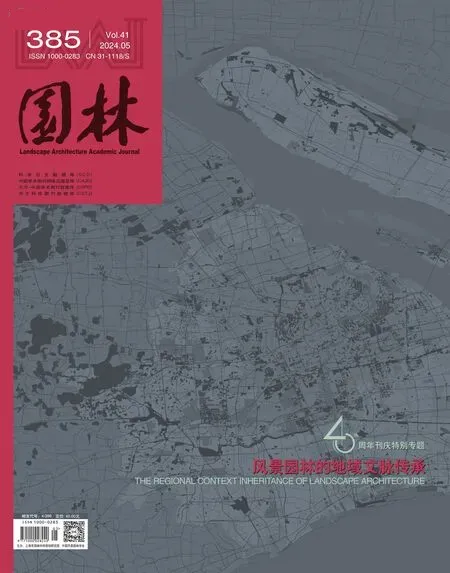风景园林的地域文脉传承
2024-05-11张浪
2024年,本刊迎来创刊40周年华诞。40年砥砺前行,40年硕果累累。特别是2019年转型学术期刊以来,本刊始终贯彻立足国内国际视野、服务学科学者、引领行业发展的办刊理念,扎根中国大地,主动服务国家战略,见证中国风景园林的蓬勃发展与创新蝶变。赓续根脉、茹古涵今,前期以“风景园林文脉传承”为主题,秉承“续过去历史文脉、装现在河山锦绣、绘未来国土丹青”理念,特开展征稿工作,通过定向约稿与自主投稿,形成本期专题。
“文脉”一词源于语言学范畴,直白理解为文化的脉络,抽象意义上来讲指事物存在的环境背景以及共同存在于环境中的事物间的联系。以地域作为承载文脉的介质而言,其包含了地域的自然环境、山水关系、历史文化、人文精神等。中国的国土地形地貌、水系、植被、民族、语言等均具有多样性,深耕中华文化沃土,以风景园林视角,时脉承载代代相承的时间沉淀,地脉承载得天独厚的资源禀赋,文脉承载悠久的历史人文积淀,脉脉相生相合,以实现“各美其美,美美与共”的美好愿景。
本期专题“风景园林的地域文脉传承”,聚合时脉、地脉与文脉,研讨了江南、岭南、巴蜀、南宋临安等地园林的过去、现在和未来的文脉传承。6篇专题论文主旨分别是:评析国内江南水网乡村景观空间特征与文脉传承研究进展,识别景观空间形态认知、演变认知、价值认知等6个研究热点方向,并提出构建景观空间形态认知框架、扩展景观空间演变研究内容、探索景观空间多元价值评价体系等5点研究展望;以“三生图景”为框架,分析吴江小城镇的古代八景的地方性特质,提出了在现代城乡规划中保护和利用古代八景的营建途径;从地方性知识视野再认知,提出了由场地生态关系、地方生态技能、传统生态智慧三部分组成的地方性生态知识框架体系;搭建供需视角下生态系统服务空间耦合的关联框架,并从支持和调节服务、供给和文化服务价值、供需协调综合效能提升三个层面,归纳了岛屿生态管控、系统要素配置、多元主体共治三大策略;分析蜀地区域山水人文景观的诗词文本词频,归纳蜀山云雾、岷山江汉、日月故人等8个类簇,提出了蜀韵特色空间的场景表达路径;剖析南宋临安城与西湖相辅相融的关系,梳理西湖的整体治理和环湖园林的兴造,并开展了真珠园、聚景园、大石佛院等园林的复原研究。
尊地脉、续文脉。不同时期不同地域的优秀风景园林总是在充分尊重当地的自然特色和人文特色前提下进行理景造园的。当今中国风景园林之发展,也必须遵循这一基本原则,再续以融合外来优秀文化,以推动中华优秀传统文化在新时代创造性转化、创新性发展,更好营建富含赓续人脉的中华人居境域。
主编
2024年4月16日
The Regional Context Inheritance of Landscape Architecture
In 2024, this journal celebrates its 40th anniversary.It has been 40 years of hard work and 40 years of fruitful achievements.Especially since its transformation into an academic journal in 2019, this journal has always adhered to the publishing philosophy of focusing on domestic and international perspectives, serving academic scholars, and leading industry development.It has rooted itself in the land of China,actively served national strategies, and witnessed the vigorous development and innovative changes of Chinese landscape architecture.Continuing the roots and preserving the past and preserving the present, with the theme of “context inheritance of landscape architecture” in the early stage, adhering to the concept of “continuing the historical context of the past, embellishing the beautiful scenery of the present, and painting the future of the country”, we have carried out a special solicitation work,and formed this special issue through targeted submissions and independent submissions.
The term “context” originates from the linguistic category, which is understood as the context of culture.In an abstract sense, it refers to the environmental background in which things exist and the connections between things that coexist in the environment.As a medium for carrying cultural context, the region encompasses the natural environment, landscape relationships, historical culture, and humanistic spirit of the region.China’s territory, topography, water system, vegetation, ethnicity, language,and other aspects all have diversity.Deeply cultivating the fertile soil of Chinese culture, from the perspective of landscape architecture, the temporal context carries the accumulation of time passed down from generation to generation, the geographical context carries the unique resource endowment, and the cultural context carries the rich historical and cultural accumulation.The veins are interdependent, in order to achieve the beautiful vision of “each beauty has its own beauty, and beauty works together”.
In this issue, the topic of “The Regional Context Inheritance of Landscape Architecture” aggregates time, place and culture, and discusses the past, present and future cultural heritage of the gardens in Jiangnan, Lingnan, Bashu, and Lin’an of the Southern Song Dynasty.The research progress of landscape space characteristics and cultural context inheritance of rural water network in Jiangnan were analyzed, six hot research directions such as landscape space morphology cognition, evolution cognition, and value cognition were identified, and five research outlooks such as constructing the framework of landscape space morphology cognition, expanding the content of research on landscape space evolution, and exploring the system of diversified value evaluation of landscape space were put forward; Using the “Three Lives Scenery” as the framework, the local characteristics of the ancient eight scenic spots in small towns in Wujiang were analyzed, and the construction methods for protecting and utilizing the ancient eight scenic spots in modern urban and rural planning were proposed; The research progress of Lingnan courtyard was analyzed from the perspective of local knowledge, and a local ecological knowledge framework system consisting of three parts was proposed, site ecological relationship, local ecological skills, and traditional ecological wisdom; The ecosystem service supply and demand relationship of Jiangxin Island in the Chongqing section of the Yangtze River from the perspective of supply and demand was combed, a correlation framework of spatial coupling of ecosystem services was constructed, and three major strategies of island ecological control, systematic element configuration and multiple subjects’ co-governance from the three levels were summarized; The word frequency of poetic texts of landscape and humanistic landscapes in the Shu region was analyzed, eight clusters of classes were summarized, and the path of scene expression for the characteristic space of Shu rhyme was proposed; The relationship between Lin’an City and West Lake in the Southern Song Dynasty was analyzed, the overall governance of West Lake and the construction of gardens around the lake was combined, the restoration research of the gardens such as the Garden of True Pearl, the Garden of Gathering Scenery, and the Dashifo Yard were carried out
Respect the local context and continue the cultural context.Excellent landscape gardens from different periods and regions always fully respect the natural and cultural characteristics of the local area for landscape design.The development of contemporary Chinese landscape architecture must also follow this basic principle, and continue to integrate excellent foreign cultures to promote the creative transformation and innovative development of excellent traditional Chinese culture in the new era,and better build a Chinese living environment rich in continuous connections.
Editor-in-Chief
April 16th, 2024
